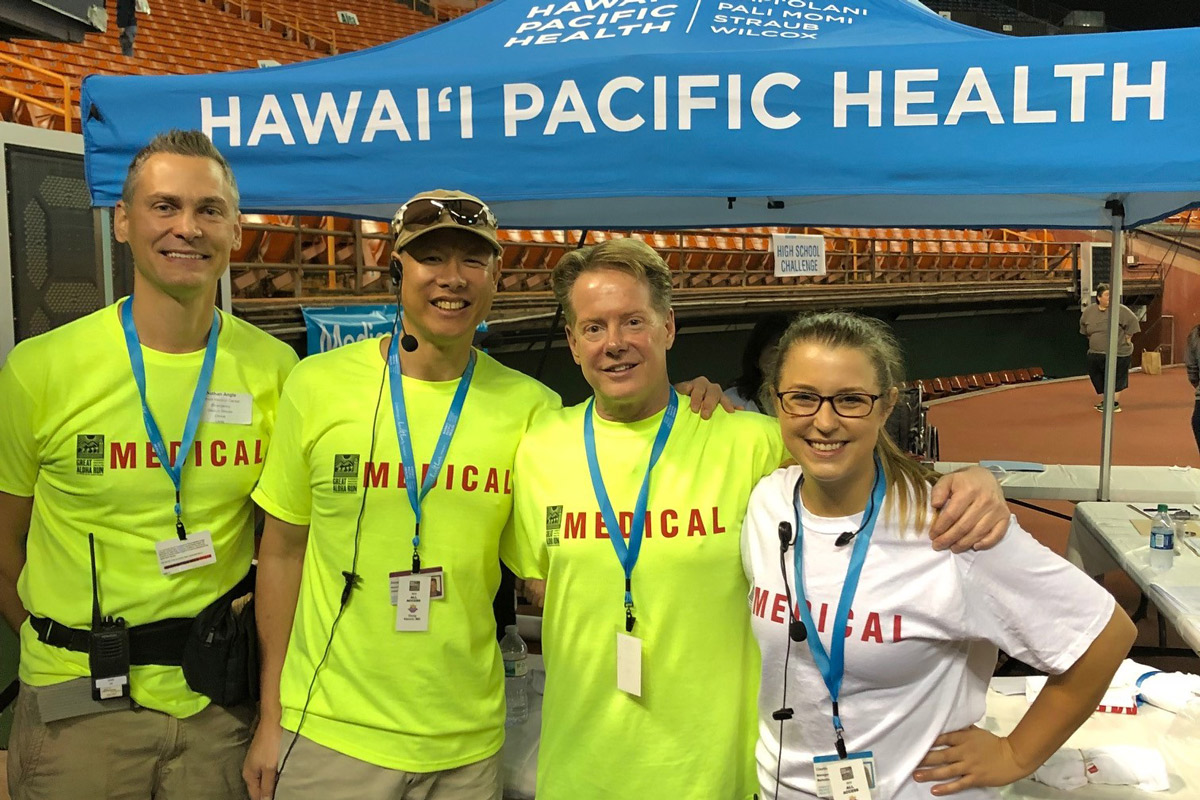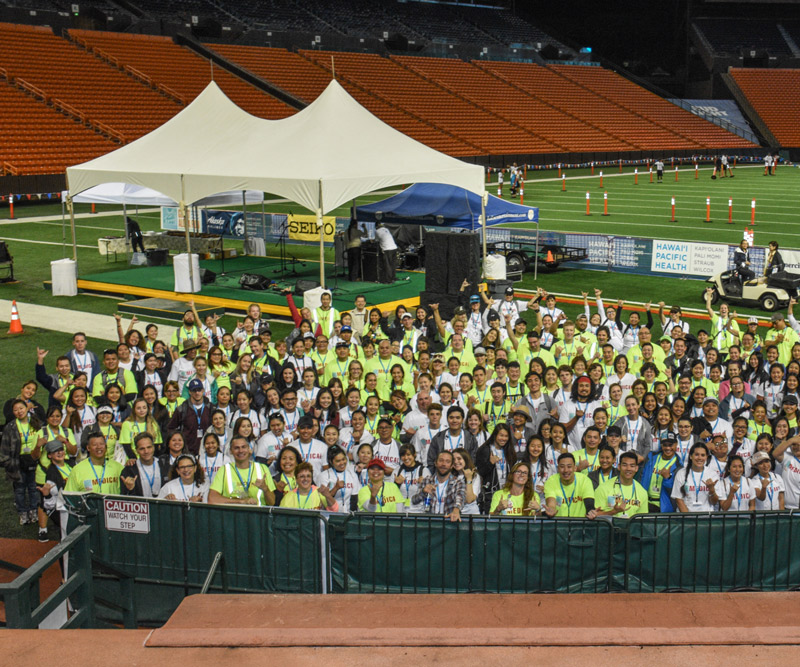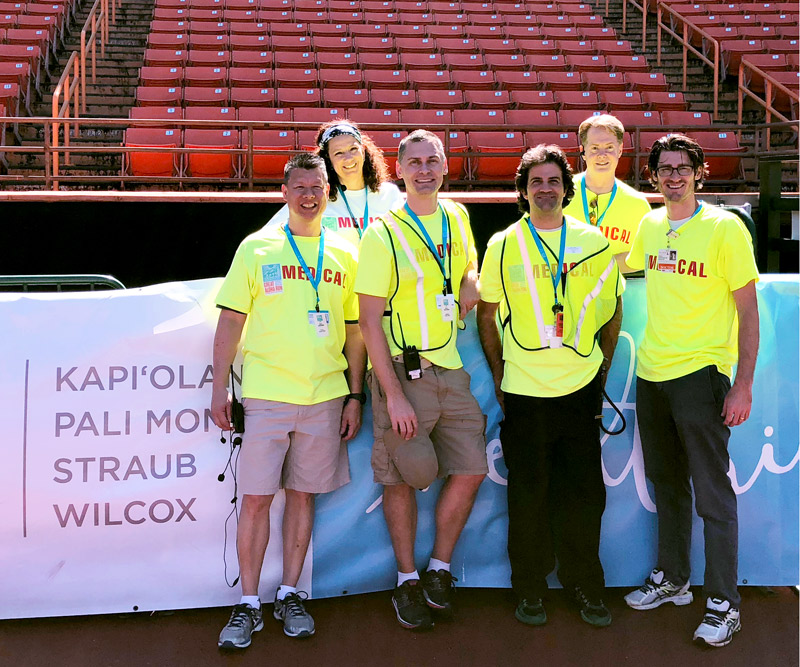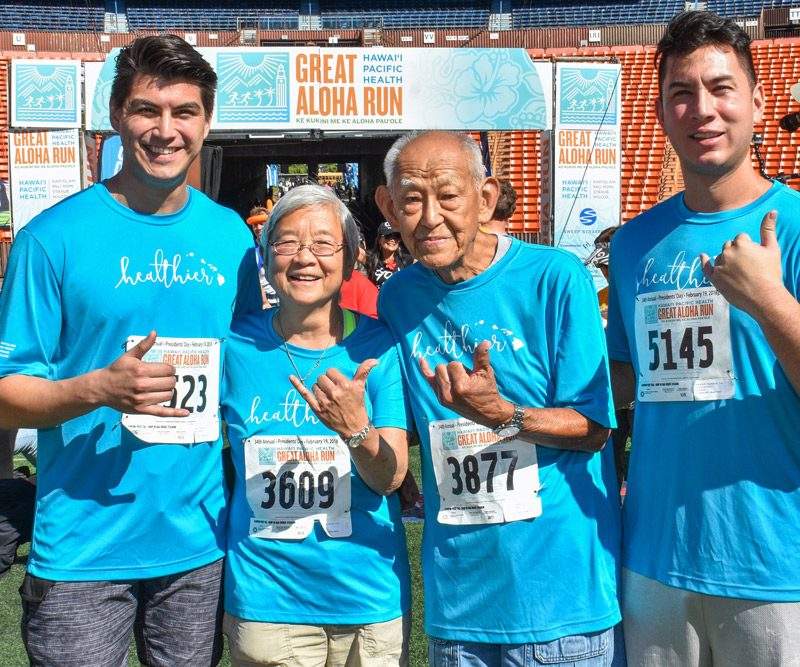
Ensuring the Safety of Thousands of Race-Day Finishers Keeps this Emergency Doc on His Toes
People Who Help Run the Hawaii Pacific Health Great Aloha Run
Leading the medical care for a community-wide running event requires you to be quick on your feet.
Luckily, Dr. Nathan Angle possesses the agility necessary to carry out the job.
“You’ll often see me sprinting around the stadium on race day with my walkie-talkie, attending to runners or escorting patients to the locker room. Sometimes I think I run as much as the participants themselves!” Angle laughs.
Angle is the stadium lead medical provider for the Hawaii Pacific Health Great Aloha Run, which means he attends to the needs of runners and walkers as they enter the last portion of the race at Aloha Stadium.
“I am responsible for making sure we have eyes on every runner as they finish and celebrate, and respond to medical issues big and small,” says Angle, an emergency medicine physician at Straub Medical Center.
Working with a dedicated crew of medical staff and volunteers, Angle ensures the safety of those not only as they cross the finish line, but at locations throughout the stadium where participants may congregate after their 8.1-mile journey, including stadium stands, walkways and the parking lot.
“I help supervise on-site physicians and nurses, volunteers and ‘spotters’ who help bring struggling runners to our attention,” Angle explains. “In addition, we staff the home locker room, which functions as a mini Emergency Department and provides more-advanced treatment for things like dehydration, hypothermia, sprains, cuts and scrapes, etc.”
Here, Angle shares more about his role, how he prepares for race day and what being part of this long-standing tradition means to him.
How do you make sure there are enough hands on deck to support such a large-scale event like the Great Aloha Run?
We recruit throughout our medical centers and clinics, and reach out into the community for volunteers as well.
We have volunteers from all four medical centers within our Hawaii Pacific Health system – Kapiolani, Pali Momi, Straub and Wilcox – as well as from various high schools, colleges, residencies and fellowships.
We have family members of staff who also volunteer.
Is any training provided to volunteers? For example, how do you recruit medical volunteers, provide the right training, prepare the medical supplies for the course, etc.?
We have an experienced team that provides outstanding training including a handbook, online modules and classes. They also do a great job providing first-aid resources carried by each spotter, as well as more advanced equipment at select areas along the course and in the stadium.
It is not easy to coordinate and train more than 400 volunteers! Kudos to Hawaii Pacific Health Marketing Manager Courtney Wagner and Dr. Doug Kwock for spearheading this campaign!
What are some common injuries or conditions you treated on race day (i.e., scrapes, dehydration, etc.)?
We often see dehydration and exhaustion at the finish line, particularly if it is hot. Occasionally patients collapse from dizziness or suffer from low sodium. Sometimes pre-existing conditions like diabetes manifest due to the rigors of the course and race.
More commonly, we see scrapes and bruises, small cuts, ankle sprains and blisters.
How are you and your team preparing for this year’s race?
We are once again recruiting and training our numerous volunteers from many different areas with various levels of knowledge. We will be providing them with adequate resources and training, and distributing them about the race course uniformly.
We also take a hard look at races from the last few years to see if we can learn from our experiences and provide better service.
We put a lot of time and effort into meetings to troubleshoot potential problems and various scenarios.
What has been your experience over the past two years since Hawaii Pacific Health became the lead sponsor of the race?
My experience has been exciting and humbling. There’s nothing like watching 15,000-plus people cross the finish line with huge smiles on their faces, to see them celebrate and greet family and friends. All runners, whether fast or slow, cross the finish line with tremendous pride and feel energized. It is very inspiring to witness this first-hand, and gratifying to help those who suffer illness or injury during their efforts.
In addition it is a lot of fun to work with other departments within my medical center, and with folks across the entire Hawaii Pacific Health system. It shows that we really have some of the best people on the island, with huge hearts, who care about our community and a healthier Hawaii.
What does being part of the tradition of the Great Aloha Run mean to you?
It is hard to believe that the Great Aloha Run is now entering its 36th year!
To me, the Great Aloha Run celebrates the outdoors and physical activity that so typify Hawaii and its people. It shows how we come together as a community and celebrate fitness and achievement.
Every year seems different, and you can see so many lives that are touched, from keiki to kupuna.
I am so proud to provide support for the thousands of people who participate every year from all over the world.
Do you have any advice for those gearing up for the race?
Please make sure that you have adequate footwear that is worn-in and won’t cause blisters.
Make sure that you hydrate well, not just with water but by drinking sports drinks as well to maintain sodium levels.
Watch your step, particularly early in the race when there are lots of runners – it’s easy to trip in a pothole and suffer a race-ending ankle sprain.
Finally, once you cross the finish line keep moving! Those who stand still can find the blood pooling in their legs, causing dizziness. Keep moving and let your body cool off gradually!
Published on: February 11, 2020




